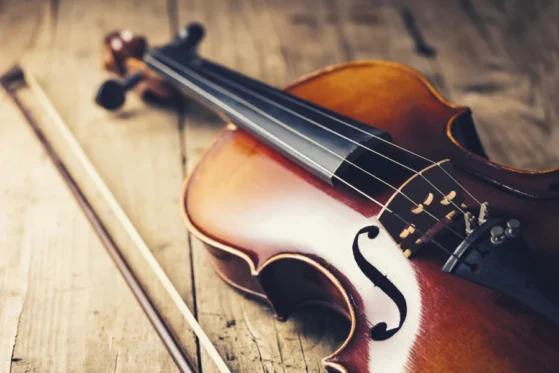Is Violin Tougher Than Guitar? | A Comprehensive Exploration
Choosing a musical instrument is an exciting journey, but it often comes with tough decisions. Among the most popular instruments, the violin and the guitar stand out for their versatility and rich history. However, they differ significantly in their learning curves and challenges, making many wonder: Is the violin tougher than the guitar?
Both instruments require dedication and practice, but their complexities arise from different factors. This blog will provide an in-depth analysis to help you understand the unique demands of each instrument and determine which might be more challenging to learn.

Basic Setup and Structure
The violin and guitar have distinct physical characteristics that influence their learning process.
Violin:
The violin is a small, lightweight instrument with four strings tuned in perfect fifths (G, D, A, E). Unlike the guitar, the violin lacks frets, leaving no visual or tactile guide for finger placement. This design demands precision, as even the slightest misplacement of a finger can produce an off-pitch sound. It is played with a bow made of horsehair, which requires careful handling to produce a clean and consistent tone.

Guitar:
The guitar is larger, with six strings tuned in standard tuning (E, A, D, G, B, E). It features frets along the neck, which serve as guides for finger placement, making it easier for beginners to achieve accurate notes. Guitars are played by plucking or strumming the strings, either with fingers or a pick. This setup allows learners to start playing simple melodies and chords relatively quickly.
While the guitar’s design is more beginner-friendly, the violin’s fretless nature and bowing technique create a steeper initial challenge.

Learning Curve | Which is Steeper?
Both instruments present a learning curve, but the violin is often perceived as more demanding at the start.
Violin:
Producing a clean sound on the violin is no small feat. Beginners must learn to control the bow while accurately placing their fingers on the fingerboard. Bowing too hard creates harsh sounds, while insufficient pressure results in weak, inconsistent tones. Mastering these basic skills takes time, and progress can feel slow. Additionally, violinists must develop an acute sense of pitch, as there are no frets to guide them.Guitar:
The guitar offers a smoother entry into music. Its frets simplify finger placement, and beginners can quickly learn basic chords and strumming patterns. The immediate gratification of playing simple songs keeps motivation high. However, as players progress, challenges like barre chords, fingerpicking, and soloing techniques emerge. These require significant practice and finger dexterity.
In summary, the violin’s early stages demand more precision, while the guitar becomes more challenging as players advance to complex techniques.

Physical Requirements and Coordination
Both instruments require physical coordination, but the violin’s posture and technique present unique difficulties.
Violin:
Playing the violin involves holding the instrument between the chin and shoulder, leaving both hands free for bowing and fingering. This posture feels unnatural at first and can cause neck or shoulder strain until the player adapts. Coordinating the left hand’s precise finger movements with the right hand’s bowing technique adds another layer of complexity. Moreover, controlling the bow to produce smooth, consistent tones demands fine motor skills and significant practice.Guitar:
The guitar is played in a more relaxed posture, either seated or standing. Players rest the instrument on their lap or use a strap, allowing for easier handling. While the frets guide finger placement, beginners must still develop coordination between the strumming or picking hand and the fretting hand. Advanced techniques, such as fast soloing or intricate fingerpicking, test hand synchronization and stamina.
Although both instruments require coordination, the violin’s posture and bowing technique make it more physically demanding in the early stages.

Violin Tougher Than Guitar | Intonation and Ear Training
The ability to play in tune is a crucial skill for any musician, but the challenges differ between the violin and guitar.
Violin:
The violin’s fretless design means players must rely entirely on their ear to achieve correct intonation. Even a slight finger movement can cause a note to go out of tune. Developing this level of precision requires years of dedicated practice. Beginners often struggle with intonation, making progress feel slow until their ear training improves.Guitar:
The guitar’s frets ensure consistent intonation, reducing the challenge of playing in tune. This makes it easier for beginners to focus on learning chords and melodies without worrying about pitch accuracy. However, advanced guitarists must still train their ears for techniques like bends, slides, and harmonics, where precise pitch control is essential.
While both instruments require ear training, the violin demands a higher level of pitch sensitivity from the very beginning.

Repertoire and Musical Styles
Both the violin and guitar have rich repertoires, but their musical applications and demands differ.
Violin:
The violin is a cornerstone of classical music and is often featured in orchestras, chamber ensembles, and solo performances. Its repertoire includes works by composers like Bach, Mozart, and Tchaikovsky, which often demand advanced technical skills such as vibrato, shifting positions, and complex bowing patterns. Beyond classical music, the violin is also used in folk, jazz, and modern genres, showcasing its versatility.Guitar:
The guitar’s versatility spans a wide range of genres, including rock, blues, jazz, pop, and classical. Beginners can quickly learn simple songs, while advanced players can explore intricate solos, fingerstyle arrangements, and flamenco techniques. The guitar’s ability to play both rhythm and melody makes it a favorite in various musical settings, from solo performances to bands.
The violin’s classical repertoire often requires more technical precision, while the guitar’s broad stylistic range offers flexibility for players of all levels.

Emotional Expression
Both instruments are highly expressive but achieve this in different ways.
Violin:
The violin is renowned for its ability to mimic the human voice, making it one of the most emotionally expressive instruments. Techniques like vibrato, dynamics, and phrasing allow violinists to convey deep emotion, but mastering these takes years of practice.Guitar:
The guitar’s expressiveness lies in its versatility. Players can use techniques like bends, slides, and fingerpicking to evoke a wide range of emotions. Its ability to transition seamlessly between rhythmic and melodic roles adds to its emotional depth.
While both instruments excel in emotional expression, the violin’s complexity in technique makes achieving this expressiveness more challenging.

Conclusion | Which is Tougher?
The violin and guitar each present unique challenges, but the violin is often considered tougher due to its fretless fingerboard, demanding bowing techniques, and reliance on ear training. Beginners may find the violin’s initial stages frustrating, as producing a clean, in-tune sound requires significant effort. However, you can overcome these challenges by taking Violin Lessons Online, which offer personalized guidance and expert techniques to help you progress faster and more effectively.
The guitar, while more accessible for beginners, introduces its own challenges as players advance. Techniques like barre chords, fingerpicking, and soloing require dexterity and precision, making the guitar equally rewarding for those who persevere.
Ultimately, the difficulty of an instrument depends on your goals and commitment. If you’re drawn to precision and classical music, the violin might be for you. If you value versatility and enjoy exploring diverse genres, the guitar offers endless possibilities. Whichever instrument you choose, dedication and passion will be your greatest allies.








